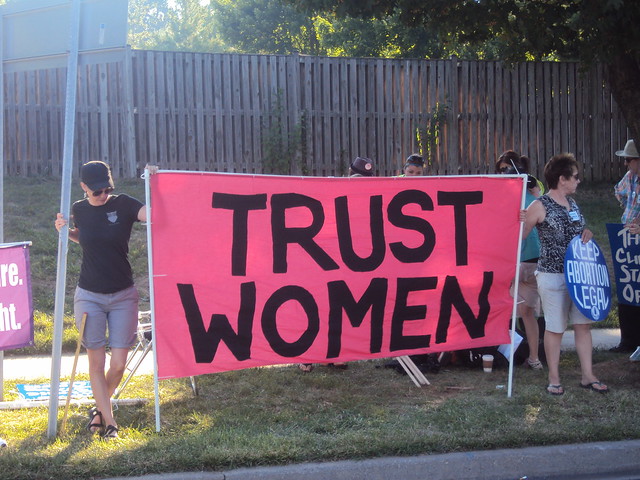 As the topic of abortion later in pregnancy has risen to the top of news cycles, many people express disgust at the idea. Even some who support abortion generally are confused about abortions that happen later in pregnancy. President Trump’s comment earlier this year stating that “Democrats are also pushing extreme late-term abortion, allowing children to be ripped from their mother’s womb right up until the moment of birth,” has enraged even more people. We have been misled by much of the reporting. Rather than presenting facts, emotional appeals based on imaginary scenarios are cast about with no basis in reality. So let’s set the record straight. According to Roe v. Wade, a fetus can be aborted up to the time when it is viable outside the womb, not a specific number of weeks of gestation because viability can vary. After viability, a doctor is permitted to abort a fetus if “necessary, in appropriate medical judgement” to preserve the life or health of the woman. On the same day they decided Roe, the Supreme Court also decided in Doe v. Bolton, which ruled that clinical judgement “may be exercised in light of all factors — physical, emotional, psychological, familial, and the woman’s age — relevant to the well-being of the patient.” The Court was saying that abortions should be limited after viability, but gave the decision-making power to the woman and the physician. Abortions that occur after the point of viability happen because the mother’s life or health is endangered or due to fetal anomalies that lead to fetal death. In these cases, there can be no C-Section because the risks involved in that procedure would also endanger the mother’s health. Now that we have the law laid out, we can discuss the issues involved in abortions later in pregnancy.
As the topic of abortion later in pregnancy has risen to the top of news cycles, many people express disgust at the idea. Even some who support abortion generally are confused about abortions that happen later in pregnancy. President Trump’s comment earlier this year stating that “Democrats are also pushing extreme late-term abortion, allowing children to be ripped from their mother’s womb right up until the moment of birth,” has enraged even more people. We have been misled by much of the reporting. Rather than presenting facts, emotional appeals based on imaginary scenarios are cast about with no basis in reality. So let’s set the record straight. According to Roe v. Wade, a fetus can be aborted up to the time when it is viable outside the womb, not a specific number of weeks of gestation because viability can vary. After viability, a doctor is permitted to abort a fetus if “necessary, in appropriate medical judgement” to preserve the life or health of the woman. On the same day they decided Roe, the Supreme Court also decided in Doe v. Bolton, which ruled that clinical judgement “may be exercised in light of all factors — physical, emotional, psychological, familial, and the woman’s age — relevant to the well-being of the patient.” The Court was saying that abortions should be limited after viability, but gave the decision-making power to the woman and the physician. Abortions that occur after the point of viability happen because the mother’s life or health is endangered or due to fetal anomalies that lead to fetal death. In these cases, there can be no C-Section because the risks involved in that procedure would also endanger the mother’s health. Now that we have the law laid out, we can discuss the issues involved in abortions later in pregnancy.
First, let us acknowledge the reality women face when presented with an unexpected pregnancy. There has been scant focus on the woman who is involved in the procedure. What brought her to this decision, why didn’t she have the abortion earlier, and how can we support women who are in these difficult-to-navigate situations? Each one of these questions can be answered, and we should use the answers to help develop better policies rather than call women and their doctors “monsters” or worse “murderers.”
We should start with some facts surrounding when abortions happen and why. Only after diving into this data, can we begin to think about policies and solutions. But before we get into theoretical discussion, we must recognize that we are talking about real women making difficult decisions for themselves and their families, each and every day. In thinking about this issue, we should also ask ourselves what if the woman involved were our spouse, sister, mother, niece? Instead of thinking about this issue as an abstract moral argument, we must bring it to the personal. After all, statistics tell us that 1 in 4 women have an abortion by the age of 45 in the United States, so most of us know and love someone who has had an abortion whether they have told us or not.
The Statistics
The vast majority of abortions, 89%, happen during the first trimester of pregnancy. Another 8% happen during the second trimester up to 20 weeks and 1.3% occur later in pregnancy up to 24 weeks or at the point of fetal viability. Of that 1.3 % of abortions, some are attributable to fatal fetal anomalies or conditions that would endanger the mother’s life while others are performed because the mother could not access an abortion for various reasons that are discussed later in this article.
What brings a woman to the decision to have an abortion later in pregnancy?
Women who have abortions later in pregnancy are no different from those who have an abortion before 20 weeks. In a study of the women who wanted an abortion for non-health related reasons, the researchers found that women who seek abortions later in pregnancy tend to be younger and unemployed, just like women who have abortions earlier. These women have typically discovered their pregnancy later and by the time they find out and decide to have an abortion, they have fewer options due to the limited number of clinics that are willing to perform abortions after the first trimester. This makes the abortion more costly and frequently these women have to travel. Many of these young and under or unemployed women must take time to gather enough money to both travel and pay for the abortion. If they are working, they must take extra time off from work and pay for a hotel room. All of this takes up precious time leading to an abortion later in pregnancy. Women in this situation are not there because they waited around. They are there because the anti-abortion lobby has been successful in making it more difficult to obtain an abortion. The roadblocks that have been put in place in many states bring about the majority of the abortions that occur later in pregnancy.
For the women who have abortions later in pregnancy for health reasons or because of a fetal anomaly, each case is a different and painful scenario. These women wanted to carry their babies to full term and many have made great sacrifices to do so. However, if a woman’s blood pressure goes too high, as with the common condition pre-eclampsia, she may die during childbirth or beforehand. Additionally, the fetus may be underweight and malnourished.. In other cases, a deadly fetal anomaly causes the mother to decide to end the pregnancy early. In none of these situations is the decision made with anything but care for both the mother and the fetus. Dr. Jen Gunter, an Ob-Gyn who has performed many of these types of abortions, writes an excellent blog describing several scenarios where it is necessary to perform an abortion later in pregnancy to save the mother’s life. Many women, like Kate Carson, who bravely shared her personal tragedy, didn’t think that they would ever have an abortion until they were faced with the situation for themselves. Carson writes a compelling first person account of how her views changed once she was faced with the reality of having a baby with a fetal anomaly. If you are interested in this topic, read the many personal stories that women have told so that those who have not had to make this decision can understand the pain and grief.
What can we do to help women avoid abortions later in pregnancy?
Most would agree that, if you must make the difficult choice to have an abortion, it is better to do so as early in the pregnancy as possible. If we are serious about decreasing the number of abortions later in pregnancy, then we must make policy decisions that will support that belief. The following steps would reduce the number of unwanted pregnancies and the number of abortions later in pregnancy. We will never be able to bring the number to zero due to the health issues that were outlined above, but we can put in place policies that will allow women who want or need an abortion to be able to access one earlier in their pregnancy.
- Provide comprehensive sex education including full information on how to access and use birth control.
- Stop passing laws that put up barriers to accessing abortion services earlier in pregnancy. This includes funding for health care providers who perform abortions.
- Provide no-cost contraception.
- Require all stores that carry the morning after pill to put it out in the regular aisles with other medications instead of behind the pharmacy or customer service counter.
These policy recommendations will reduce the number of unwanted pregnancies in the first place. If a woman does discover that she is pregnant and wants an abortion, she will have access to one in the early part of her pregnancy. Unfortunately, policy makers continue to pass laws reducing or denying access to basic reproductive health services, including abortion when necessary. As a result, women who could have had a simpler procedure end up having a more involved procedure or end up carrying to term. We know that when sex education and birth control are readily available, the abortion rates go down significantly. If the anti-abortion lobby is serious about reducing (rather than eliminating) abortion, they would follow these guidelines. Unfortunately, they are more interested in eliminating abortions altogether, and are willing to use misinformation and scare tactics to achieve their goal.
Anna Lynch is a writer, educator, and champion for all things women.


There are no comments
Add yours